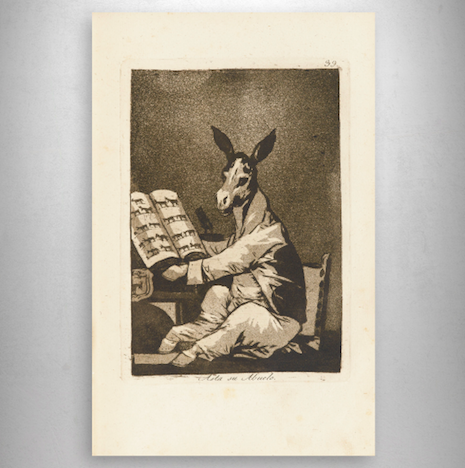International auction house Sotheby’s spent 2017 focusing on bringing new, innovative ways to its consumers so that they could bid on high-end items through digital means.
These tools, ranging from online bidding to video to social media, have driven an unprecedented increase in online auction sales at the house, totaling more than $180 million in online sales for this past year. Sotheby's successful practices in 2017 is a great example of how the digital revolution has affected every corner of the luxury industry.
Digitools
Digital tools have had a profound effect on the way customers at all levels shop, but for luxury consumers this is especially true.
As these consumers are increasingly accustomed to having the highest quality customer service afforded to them, digital tools such as livestreaming and comprehensive mobile shopping apps can help make an online luxury shopping experience just as smooth as an in-store one.
This is the strategy that drove Sotheby’s in 2017 as the auction house focused on driving up online sales.

Brice Marden's "Cold Mountain Series, Zen Study 1-6" was included in Sotheby's March 2 auction
The results have been resoundingly successful with online sales up 16 percent and online underbids up $500 million and 27 percent from the previous year.
What is equally encouraging for the health of the auction sector is that more than half of all these online sales, 53 percent, are new customers entirely, a record number of new customers in one year for Sotheby’s.
Sotheby’s attributes this unprecedented growth in customers to its increased online activities such as partnering with online auction houses and offering interactive digital tools to customers.
Nearly a quarter of all sales in from Sotheby’s in 2017 came from its online auctions.
Online auctions
One of the primary drivers of Sotheby’s digital innovations this year is competition from major ecommerce sites.
Sotheby’s was aware that digital auction sites such as Amazon and eBay had the possibility of damaging its business, even though Sotheby’s is much more high-end. Instead of attempting to take down the new trend or ignore it, the auctioneer partnered with eBay instead.
The auctioneer invested in online auctions and partnered with eBay to live stream the former’s in-person auction on the latter’s platform. This allowed Sotheby’s to increase its visibility to those who would not previously have had access or been aware of its auctions (see story).

A Francisco Goya print sold by Sotheby's online this year. Image credit: Sotheby's
Sotheby’s also built a highly in-tuned audience and notifying consumers of relevant happenings via an online platform partnership.
Through a partnership with the IoT platform IFTTT, Sotheby’s is allowing customers to customize notification settings so they can stay up to date with what is happening in the auction community. The platform integrates with major applications and other platforms, allowing users to set up a personalized experience for each app based on preference (see story).
But Sotheby’s innovations have also caused its competitors to enhance their own digital toolsets.
For example, art and antiques search engine Barnebys has completed its first acquisition as it looks to strengthen its position in the United States.
Barnebys has purchased U.S.-based Simple Auction Site for an undisclosed sum. The Simple Auction Site was founded by Bob and Steve Freedman in 2005 and supplies software bidding systems to small and medium-sized auctioneers throughout the U.S (see story).
With a year full of digital successes behind it, Sotheby’s is looking into 2018 with an eye on continuing to increase its online presence and bring in even more online and digital customers from around the world.
{"ct":"aNM+tPW28i2BQAVM7d4pNN1s8l3PXXhbigNhrlgGUzdgqXgDApOPOkBmo2hXA1wpBLVWMSEjgFB6ZCpG0UH7F3pcKC8YCvTpHUM1yyf3NB3cDJU4u2Sx65YSWWWKptT\/6kYZOS1AvIP9r4QaiblBJlzF\/Sj3tEXw82OJZBz6ffX+gUa7HTQinFlYTv\/Y1+CWN+iPp5dtrvAeaeyN+dyVuAk0eB1M0Rp361VmK0FLxQ0jjNeul0aZAITc1f5WR5mCZZLc88mLRmM\/IqA\/R7UupuNzth3l0vmwoGad\/gDOmndlY\/eaqrDzxTtCWVkzbMWQI475DZ\/PcyxixuuzdqRQcun03W4mnsf2lx0WgEhnlHBXoMdsdikcu3YwraiaJ8iuh5nYqQkyoxjLY8ylHIx\/hwXAQagonOxbr45itrGqlAx0NeL2RMxK7a64ij78oSc5jnONDVudv4rbNppu7JdxaXTkosuCXZgj1MSU5wGrNUEFOrN8eqDA3\/GJ6p3q4FsV5pHvk1rCFfUR83Nzi8oA8eWl0GcszA4FDVFF42bMR5+BcKaZX1fqyPX3x40uB\/aZYRdmIgJd+h2JGe6NFcPiJzDd8IHp8mNt9B3rS6fEofqjZ4kChjTih8e+GEFKSzfBxxh1XClC64+UvFMGvtr2BFGfmp7YqesDUlOyctjtbqxsCbT0dOalse32abdLGtHUBnP4vyOUs5\/4m7Ex4D35iMW8r7NOZk+WqTX\/su9HlplgyTtSbo3891s+IMiPi40Jb4QZVyj9vMyW75myhl5gVSN8vii3UDOlsinNsu90EdJruOX0pmHJ93ELy\/DlfZvNfoQyFUL\/x\/rnEt21Uyzd8j9UEMQm2LM11eLJl0kSlzXFMUeAlUJppdF4ENJDHTvM7Q4ukKJx4P1Q56Piu3sj30iSZEmaD8LJTAikcWZMY7JJOb\/JNwYBTnk+fvmrE++aotr\/8kNc3MCe7tN3f6Jb\/iOx7Nw0EFwX76bBnAbf1SwjosXtsONIhypBp32pFBL+5vtmE1Y8nc5FD+MEFoo9pe6+oPsjoXT+S4AoiCvJ5q9nA+iIuJE01yOHLrh+WT9s0J3SWPEN2iqxZMKkPue+qNFK1B2F4qhWu9wIbgTM8R\/ypmT0Ry57wqb7inrDFrb4jvOe1IuG\/rb0J4A\/O5Z2YjTpWs\/q\/oOtw6Ow5eGvVkR3F67gAvi3MPly84Vo6WRgMlHo\/pEZ5d5xbosHs03AIpNU1i\/vPXpGXiNFnVAoJp6tQy5vtm5hgLwwBoIE69hJptjodrl2CZk9U1kdNe5eUCwOdHx3EcW8k16trbhlYD9mqMO5a0AuMQbZ5nmN5TWi92CrbEfzhes12fBU3ZKHsjD0kT8wfNcooVg9aoebG2zc69xLgXJ4rPMGbYvjl+YlCUz\/9AibsnH29eFBzR9EAG7s5OhK4anO9R1U3mVYavvNAfQrZVkr5IT+D+7jN519FBj+yon3jezPGnRKhX4ceZvBqZruf2sK6BCvYivkDwWDCvjDi5l709LS+PDT2Dp5kd7Em\/69ARUL2LnmfvC\/sNzXROuQwUamxevJQO7tUdupgYioZhNMdhcvcNpE6zX3r4FxP3sbRpjjqrYu6w4zFeJ+6JtBNwue2ifD15YGrLRsxRighviyb0Ix9JxdZL9yOiYqjrqDCo3vlPvL5dghPYSQF9Zcb+W4i8lQz\/HkJjmMH7ZGYPdh+YPrndQge9h4j1N7\/4RLOM+Ei5xPZlIfpMFSUTGkv3Po0XgCJ5rb\/o8Vqeac3PmtAj0TwZplO2\/oQfPH9\/pqy6B2w7DSKZFUuSpwRpCjGUEizL93rr1yNo4e4BMdN9GjbCUhf9uL55LaqP8OBckqT9uHRHCvKBlYVyaw3j2Dg9U9t2Z\/CdNRi2e+hbTDDaCLztoxGO2I3XPj13voqYEa80\/\/bNdq8mfDCLyZ6yCpF5okZEUt7m49zg4MrJpIxfCrx6YW41ZCJ7q93sK\/Fznnv1Lkw9azkEqsD8HPgfj1ENdrgkSX6k6drdLRBHh1a6AGZcRcK9OuSLl5XNGShw5JLHQov7rTqPAtcN92syGeKuXicM\/XkoguZ3R\/zwHOubhK3rL5BF1kOj+nvJI1dOCLPs8lW50SVxhzWBuOCXBTtvymcwKrIC47y5Q+QqXfpCnM3+2Cn2x+Qc\/p5x+p7ThBUb7ogpZcaTX6Wp+2SgTuyBNMto7pmuJ7687NLpjLTteNvkjtUf0viFVhXo73EpQvw7\/IAdR9O5uFNu9RtKxrxLVw+rKfDHRYFq2dCjktWyY9SxlvIglAu5IpDa7haC83NAlx1ifGKqzf+AoV5+gVxdiLEY9TAM\/M6NFPWtwQdf1\/l+2wUYEKgvP553JLIGRyLwwDuZ+UV+wCUlGNhGuRNANBDL3FGqoz6OwXHcMPQQff3M7MabU\/WFFpu1FBi8bzsWApTUnMSneIlkzTkv0styiVy+CeL4NMWC1GwR6OEPO4IYE6D7LJfERM0AGJgo7v3mxVecttfw5I+\/vSbTmlZTW8bDkLmMUSw2ewwTBZzzDlqPJ\/OPctp9vRLe88RT6hciVlEVETGVPEFkr0wvYsDcrToI6Jsxx3opJY85CsGM3S89kyfz5yh7vvuz64JkSGOrpkflk8U\/i5R2rf\/9jCpzncasNhMD3IH+UaM5L4q3RuM85fi\/plyy1GGLYpiafaIYjakROo7OYMEE6NGAiaefQIZ4TX8edX0DlZP6rFAbuzT1PbuCZP59VkoeHZ1FYJFxFP9xk3PyhZLiDYitYArDzxDlAy4Rc6OhsAOYcqtUF\/nvdiwNmr9Ht80dQ6b1eEB7HulDAdW6vYWTwYohcTbDBf5Fx5Q8\/TlC6i5Y9IT15Ln1kh\/FnAhmmKggLOVRSclT6SiY30iNSZggG1tPxS\/7SmA2+hleSYbwkOOrOXJDcf870vqucZKu2b7I9JpEJ2k0rFVofE8ha7jb860tVtLl\/niJy6WDKh5iwBuZa+Oss99cUdCIbHdPHuYujnj+QfvZDT1pdrHR0NDE7xNy8ECOJD8Gr5VeIqJmZTHuxx0ypQ278mJ9tQBSa6RwK7b31qGXejI2LrtMAcFQ55vJPNqbYaruNxv5mwxr5yjdHKg9Cj8mPaqEhyqB7jfF5aGl6hsTk8FqgpIk2pT6nQAk6qYM3Bum0kLD4FJXuRtcPASxMC0XLet6lrYcU8WMabgKkKFXuwZBMyR10fT5byJ7iFmWmGn23vFtdmNp5YX2p17tVZrbf\/lyJcRl\/5DGvL3tAfWQ\/TKHq\/6JcWBlSwU0EGjo1sz3IaWbpjCNmfuxvkPbDnhFOf\/k8BWnJkWe8E49UpQicM6iFl08DivVHyir+zxrLU2euAty58XNuKDURyXwt0RkZt726STFsiRNnLeBk\/xHc6vHFukzytoi1e6e4kmqtWKcZHIcx0m1XxGxnjrs1KtKpPRlqpDvfzObeuINUzupmGif3kFWuvJmi+eZkJqK5RwFaMLxgD5Vv2Pnfauz7ZrdB53VYM21r5r3lHJcn9nlJeofYRHuCAEAZI3YRoLDzpB\/I5R\/7E5wvL5GiODf5Eys7W0oAo7fJmZHIK79AoTXmgBGcli+pss2aL19F3n5Dq+kWPuN3fsPcaL1xfMUoPoHUjURQgRHYinMjICel3D7I2p8TmNwPReIm+R59UR9VC0hbwdB1\/rVEVCSP4zR9a4KqhqSuGstiZJ1FCYuDAIpb7YfxhodTar5e0OLgdmI1QIOL11I+q\/N9MMkLgUCCTOjXT\/MWQ3146r0\/c60mzHVymstrhjJxz15wo9C7y1Cjljc\/23lqha7aEMM+K7vqcNz8wOKmkFz1xt2xrkAcIvV8IioQf9iyerMSE+ckJh94Jl5jKFUV8ht4mp+lOsCdnraVWaFulJmS35TOGYST12JBIsHOz6gYIbsg9A2g+4ysuQoayV21ewf1mTkd\/1xEzHt\/n6NQWgEBxf4BCZVmtdTtDv1HyxQGCZiB8uNMMHd40yEZPJEQ9Zg2xFev+aldjciH+j+vCgSbZnJ+asMnVSg0dYftVkjca5QWy3ndX\/TlpSkQH0ojPoXX0uPjy9lz+vKbMqk\/VTtC9guPfHtyuoVt5BD2egqj4A\/1OcsHcKrziNW7hbvLFnCMZEC4Dt2t5HdCPd6SU5\/EnwK7tF2X4h08K7\/KZAozNjlS\/VVrtefl3n2cauKj2rkWv9z5YUdr63e2+iPoWBEIg\/fEKuwTFWMtHU1StRqX8ArngoHkGG4xUqz5apfUjgKPhh2MED1+gzlByhY82t9MRgNGd2x8r4MuhqjKZdyZttA7Za9A4euna4yNvU1+Y8+C5NWR0XDan54mGVbGZ+Lkr7joyz2mT6GuwuAEJNVJNDINBHUwXKGpTJj3KfSPrJXb8EmxoFmRuSkIdADMMfLVA\/o4GJoJz7Bh\/8LCmIK0yTWAmYN+Ci9Zn0LpSjotNpOOy1VO8fSPBm5VvmGfvF5KAe3oAVd+WjH7B9VdjxXtuTSBIiK9iKEjWdGDNM+icmSw8YaL+9ZjqhWPCRXCf2EgfehHFNa8aHs+ufpdL5l3v8DaqwFV4uLYlYZmaBVwrCaVM+F\/C09EWJbD8b5X9YnFHvI9odmJg1sHd\/1Tohks0Oo0hvnCsHYe3f31ab0CxBhwQW+jxUdFYpLDIUMEg1plpKjMvpQ38viq4Efn8JfDTr6S\/6tEMG8EteQsh4Qb3M4nrQC+45ShY9REaqZvplI2\/\/tCf\/q5rz7kIBSCswVPPxM9PaaOQgRcb4eU4RainK\/Fzc+2RoiRK1fAn23GY7ULjC0dsT4vSSmK4tk0nDKV2wiHdo2HWQ3Ws8vVnyw8QQPSryAXJFAoguwyC\/r5SewtwX9XZzME7Ht2yKu2vSLdE9GdVgsGES+aeCHGO9+h+DQ5HN4+VE3ddPNhnGsJu34+Xq7GtARGpavxEtf9N8AowOs0LI2UYIO0UrBMexERe+vxyT9HpRvLhGIpcEwyE6qVxTEcqV\/SJuOkXnhmJefOpSWOUj8iA2MREbVvjhGZa175QPldr6WwtknzAN8JwmvafdFNOhEALjI3XHFjtYE4UdymtTuOFiesXfI3s2lUkoJQXToKiVjxJT1PEkOE\/y7iAJ2aeojfLDyEhUeiTIOS80GPhp4fVrkhhZk9ZiTkLOPzS59S691roiTkcT7B4wU\/i\/eL+WlXtVDyvWCiTxtuz5aZ0Lix26qhRY\/SE3Kqc9qLziVkiwvLTb3\/3RaczJcgGYg5Do5hC5RVCF42ICB5nk7tPfIvAkg0w\/ng+xENzo5\/qLIQlZf4VlngNRQkhPAawu4Tqnx9VQ+LWTJtLgcJybD3ZenCKnYplDkbe8bT8VK5L1w7ed2tSqhx8DQc9FqAx8NON+QbBsxJKhO0J6+2vw5\/VdwYhmM8KERgVWc21\/oc+18+j8ouGnOAMkBpbTSmkgdcNp+WAfGFgICp8bSEXiCeoZsJMEn9wUbYOhIBxLl8MLrBMB5Idp84E1vxhNbWLYhbEWcysVJeyzAgIA+f567CSZtNW2tOGf9vvkhYSZpJiHvqm\/6fC9JcSs\/bl8bjEB9Ev5CaUP+FSSNvvclmzN3EJviitcVxYxIJRLh2iMwEB9eX3p61l1dLBiL1Ffb\/DClhfMXl1cIfelk5rzXA4cE5UnybQfqmGkUvSnwq5HJEDPN0ynNmicEr62hFpLmKXj9dA9hm15hL3ACiXitCoTp3UF4Vu2CE0z4D1BMT2KdDsDV3VcsYsxwzl+W\/YsL8j18UmTG0u3c\/QeYSoJWN3vZYnRA1XK9qXJPydTcMbxqSqJcxRFWuh146CUDjLu2Ljjma5zd61d7Nh7ukGlywqVtG28Ek5KT4toTEVbwLqoDEtw4LJK1nnKhbI1jsuNnnPNahp+psd7BF\/TIhHR8BiD9KaLC52GuRGwfq7TEJH8Nb2bVI6f\/wY50wHA767cQjcxmJGblpz01NLJAJ4XaL4v13cCojkhE0Fpzm1EZrs617Tbik2t7uBFOWjEeGOTiW4iWdlmeQeq4Owl\/Sh2amWW7sVS7vQex2zfsjI3uSZxb5IlqrrKlFAUGifPPtRjiOBYSeplPXAqXI+Uf4T1r+ZP0u+67ZrckouYRJALGLHrYvjMluo9qSmoYp+2fp8Lr1lgAfgSEhK+TXkh48XncD4oepuSo\/dKWYMZWziUHp\/D+M5Dg51+KFRpPZyDFM\/k6bvtBY2TYIYAPo5Mxiz2Tk23K7mVV5MpnvIsIZmb1Es0HtyeoAl4IC3c60dhyeva+j6CgblQz03MQViF+8o0cbASTXcmRdBF3DHQVcat15xklKGFh\/\/o5PA5QxrqW6iiPCm\/n5PRryKIF\/f\/ETw2NU14j7Mvl35fNrWCEmK\/dHdN3urwUR22p9jqVef\/NgJdyv8iQJMEfTTuvjDfqbu6pR7nnoHjntDwpYXjC1dSMZPTcNeyFclGKu1YdRCx3Jy\/i\/tanNQLwE9nxUrNTdXTq9SRgKISy3fP0NJns9S9XY3simcul7ekaBvL61x9AdEsY1YejYHcxArukFSiOabogKj87WuVDCNlb1u4B+Lu0U8aWDZyLF3Kw17k9axpfaZwm1DqgmpDkdGCyR8rg7glDRpG3gajeMYJ2CbJ8PkIkXEwQn3\/k2Ti4\/Z0rn22Fg8KSRBzvtw0MjCOZZIaqcQdc7AARQR2+zWXSndvp9GuWSHEAIguFaWLVAm5RHSpmr2CBElJ744mOkLx8PG\/XTszi5uja6wX1S\/zk2D5nWhlM0W91QeFf++LPodO9xYrF0IQLFOJTwOIEwZOyUJz9oGoSatCZ9Q3pLFRUSuxp8bVY43VCHRUh0Z5l8FpYNcKRznLDh1CYuZDGC1MaouLSQ+fHHW4\/uxr\/nEhOwW7t01U8q90Mtx7dcFdoOkt7Y34Rq94KLYksTmjRwSfyMajnlLhYTr1QiBq6fxIc\/pP6jk0xzuNTM53JMHgp26Xdom5fbY1As4GzKjWZEV7igWcPNfQm9ulAsUWzxL86Xqd0Z\/iZ9BssVHdUKwMNM\/q4QFTo+1cP85gd4L5htMQRsfJncYf6O6s+wVD9WzYWkVYkFXaocEXCu8gdtZsikBfYXx+MISTQloOIXl\/QJoRZZ9i3O2h9JJteDhI8gbKwYp0bbfbuVDsNvtcI8OTCSjeL8rvHrQmD3y","iv":"05e48c4a3431258c936c88b7e03c0887","s":"e9cf4c5e848d2312"}

 Sotheby's sold a record number of online lots this year. Image credit: Sotheby's
Sotheby's sold a record number of online lots this year. Image credit: Sotheby's